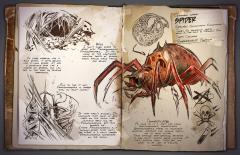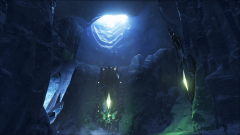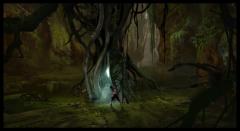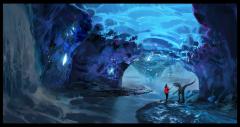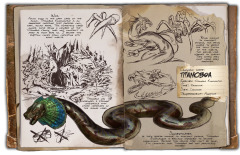Search the Community
Showing results for tags 'cave'.
-

Tenebrisaurus, the New meta for caves while keeping it primitive and balanced
Czuba posted a suggestion in Game Suggestions
For now I am working On a project of Tenebrisaurus dossier and it's setcof abilities, i want to show ark creators the ready to use version becouse they probably put all effort to optimalisation of asa and it's mulfunctions so adding new creatures is not first in line. I world be happy to get some help from forum, but for now i will try to make my project as good as i can do it singlehanded. See you in future updates! Going back to work, Recon -
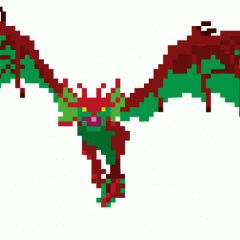
Cryptogyps lacertosus, the cheater death (big vulture)
Aazodus posted a suggestion in Creature submission archive
English: (Sadly i not have draw of it, but imagine big vulture like real one, with some spike, and the blue "element friendly" corruption like other extinction creature) Cryptogyps lacertosus the cheater death Common name: Crypto Species: Cryptogyps lacertosus (hidden vulture and powerful) Time : Pleistocene Diet: carrion feeder Temperament : opportunist Preferred Food: Golden hesperornis egg Inventory Power: Cryptogyps can store Golden Hesperornis Eggs for a very long time to prevent them from rotting, in addition it can turn 25 Spoiled Meat into Raw Meat and 400 Raw Meat into Prime Meat. Power cheats death: Cryptogyps if his life reaches zero will have immunity to the next damage, if he keeps his immunity or he does not receive damage after losing it for 2 minutes, he will regain 2000 hp and live (or else 20% to see so it's not too cheating) Bird breeder : Cryptogyps can make baby vulture, featherlight, ichthyornis and hesperornis making these creatures obtainable in new ways and in non-canon locations. They will have like normal parents the random stats of the mother or the father however they will not be able to reproduce with their parent (logical it is not the same species) and will act like their natural counterpart Taming Method: Passive To start the taming I know it's contradictory but you have to kill the Cryptogyps then you have to make sure you lock it in a safe place but not too small or else it will refuse the next step, to start you have to do a bait, to do this you must put a taxidermy with a corresponding trophy equip, the bigger it is (so alpha and apex predator) the better the taming will be after the fight, you can put basilisk alpha, karkinos alpha, giga, etc, he will be attracted and you can lock him up to kill him, then once his power cheats death is active you must catch him, either by a metal bolas or by a megalosaurus (be careful, this removes his immunity) once you catch him you must wait 2 minutes (the time he regens, then you can release him wait without attacking him for him to approach you and once ready enough give him a caress, then depending on Cryptogyps's reaction you must react, if Cryptogyps attacks you weaken him to show who dominates, if Cryptogyps is imposing and opens his wings give him a golden egg of hesperornis, then repeat a caress and fight back if he attacks attack, if he imposes feed him, be careful, it will not lose effectiveness if you are the one attacking it, but if it is another creature (wild or tamer) this could affect its effectiveness. Cryptogyps also accepts golden mushrooms, basilisk egg, element ores and element as an alternative if there is no golden egg but will be less effective and therefore more likely to have to fight. Maps transfer or and spawn : Aberation, Extinction,the Center, Crystal isle, lost island, Genesis 1, genesis 2 Breedable : Yes (80% of baby will be torgos arcam, featherlight, hesperornis or ichthyornis) Saddle: Tribal Crypto armor unlock at lvl 68 (argentavis I think) add 65 armor need to craft : golden egg, fiber, hide, sarco skin, Rex Helmet Skin Saddle tek : Tek Crypto armor unlock at Dinopithecus king, crystal wyvern queen (make these boss cool to make because many only make island scorched boss and Rockwell) or the best a special boss for him because the center not have special boss)can swap mode : Add 120 armor, can use element for reflect projectile and dmg, Swap armor to dmg so normal make 120% dmg, can use element to make element charged attack, when crypto bite or lacerated make more dmg and have 25% chance to make bleed Swap armor to life, heal regen to 120 per second when use element and spoiled meat, transform with time into Mummy element after 24 hours if crypto possess in inventory many element, spoiled meat and golden egg (beware of spoil meat become meat) Mommy element is lvl of Cryptogyps who craft it, mommy element can be put in inventory of death bodies to resurrect it, but function only for tame was below or same lvl of Cryptogyps, if try on more lvl dino it resurrect but lost lvl to correspond to crypto lvl, when death body eat mommy element it transform into mommy before become alive. Mommy element can be use on wild but don’t tame them, so you do tame them by normal way. Immobilized by: Chain bolas, megalosaurus (it take it on neck), thylacoleo Immune by : Net, blood, radiation Wild : Have you ever seen a mummy movie? Well I think Cryptogyps could correspond, he has an immense power over death, able to protect himself from damage incurred or to kill before being killed, he can even literally mummify to protect himself. Unlike its counterpart Torgos Arcam, it is very tall, really very tall, it is easily the size of a argentavis on the arch, at the start when I crossed it for the first time I would have thought to see one, in sum Crypto at a pace that could be mistaken for an eagle, let's say that it is especially his long neck that betrays him, moreover, I saw him once one of them being taken by a megalosaurus that he had inadvertently just woken up, and he got caught, not something you would commonly see on other specimens of his size. Tamed: When I see some of these abilities, including the one on the element, it scares me horribly, could he be one of Rockwell's minions? He is able to corrupt the element in his own way, giving his resurrection power to creatures that come into contact with the mummified element. I've seen some of the best inventors in the Federation and URE build tek armor for this creature, allowing it to amplify its already existing powers or force it to corrupt the element, this armor doesn't do I find only worsen the threat that crypto can cause. Having a tamed Cryptogyps lacertosus can however be useful for travel, you can ride on its back as a flying mount, but you can also travel in caves with it, if the air pressure of a cave prevents it from flying, it can be clinging to your spine, being like Torgos Arcam quite light, and serving as a glider, it can hover in the air, but it can also move and therefore hover and make three leaps in the air before being forced to to land. He is not worth a draconis obscurum for traveling but he is rather useful for those who are not fortunate enough to have this mount, moreover, perhaps because he knows the element well enough to corrupt it, he does not is unaffected by radiation and elemental water, allowing survivors to travel through this hostile area well accompanied or to caves in other arks to hunt for artifacts. French : Cryptogyps lacertosus, le tricheur de la mort Common name: Crypto Espèce : Cryptogyps lacertosus (Vautour caché et puissant) Époque : Pléistocène Régime: Charognard Tempérament : opportuniste Nourriture préférée: Golden hesperornis egg Pouvoir d’inventaire : Cryptogyps peut stocker les œufs d’or d’hesperornis pendant très très longtemps les empêchant de pourrir, de plus il peut transformer 25 viande avarié en viande cru et 400 viande crue en viande supérieur. Pouvoir trompe la mort : Cryptogyps si sa vie atteint zéro aura une immunité au prochain dégât, si il garde son immunité ou qu’il ne reçois pas de dégât après l’avoir perdu pendant 2 minutes, il regagnera 2000 hp et vivra ( ou alors 20% a voir pour que ce soit pas trop cheater) Reproducteur d’oiseau : Cryptogyps peut faire des bébés vautour, plumineux, ichthyornis et hesperornis rendant ces créatures obtenable d’une manière inédite et sur des lieux non canoniques. Elles posséderont comme des parents normaux les stats aléatoires de la mère ou du père cependant elle ne pourront pas se reproduire avec leur parent (logique c’est pas la même espèce) et agiront comme leur homologue naturel Méthode d’apprivoisements : Passive Pour commencer l’apprivoisement, je sais c’est contradictoire, mais vous devez tuer le Cryptogyps, vous devez alors vous assurer de l’enfermer dans un lieu sûr mais pas trop petit, sinon il refusera la prochaine étape, pour commencer vous devez faire un appât, pour ce faire vous devez poser une taxidermie avec un trophée correspondant équiper, plus il est gros (donc alpha et prédateur apex) mieux sera l’apprivoisement après le combat, vous pouvez mettre basilisk alpha, karkinos alpha, giga, etc, il sera attiré et vous pourrez l’enfermer pour le tuer, ensuite une fois son pouvoir trompe la mort active vous devez l’attraper, soit par une bolas en métal soit par un megalosaurus ( attention cela retire son immunité) une fois attraper vous devez attendre 2 minutes (le temps qu’il regen, ensuite vous pourrez le relâcher la attendez sans l’attaquer qu’il s’approche de vous et une fois assez prêt faite lui une caresse, ensuite selon la réaction de Cryptogyps vous devez réagir, si Cryptogyps vous attaque affaiblissez le pour montrer qui domine, si Cryptogyps se montre imposant et ouvre ses ailes donnez lui un œuf d’or d’hesperornis, ensuite refaite une caresse et rebelotte si il attaque attaquer, si il s’impose nourrissez le, attention il ne perdra pas d’efficacité si c’est vous qui l’attaquer par contre si c’est une autre créature (sauvage ou tamer) cela pourrait baiser son efficacité. Cryptogyps accepte aussi les champignons doré, œuf de basilisk, minerais d’élément et élément comme alternative si il n’y a pas d’œuf doré mais se sera moins efficace et donc plus de chance de devoir se battre. Cartes de transfer et où de spawn : Aberation, Extinction, the Center, Crystal isle, lost island, Genesis 1, genesis 2 Reproductible : Oui (80% des bébés seront des torgos arcam, plumineux, hesperornis et ichthyornis) Selle : Armure tribale de crypto déblocable au niveau 68 (argentavis je pense) ajoute 65 d’armure a besoin pour être fabriquée : œuf d’or, fibre, peau, peau de sarco, costume de casque de crâne de rex (ressemble à un assemblage d’os de stego, sauropod etc Selle tek : Armure tek de crypto déblocable par le roi Dinopithecus, Reine crystal wyvern(faisant d’eux des boss utile car souvent on fait que ceux de the island et scorched et de Rockwell ) peut changer de mode : Ajoute 120 d’armure, peut user de l’élément pour refléter les projectiles et dommage Converti l’armure en dommage ainsi les dégâts normaux sont de 120% dmg, peut user de l’élément pour faire des attaque chargée en element, lorsque crypto mors ou lacère il a 25% de chance de provoquer un saignement Converti l’armure en vie, la vie se régénère de 120 par seconde lorsqu’il use de l’élément, de la viande avarié et œuf d’or d’hesperornis, transforme avec le temps en élément momifié après 24 heures, si crypto possèdent beaucoup d’élément, viande avarié et œuf d’or (attention à la viande avarié qui devient de la viande crue ) Element momifié est du niveau du crypto qui l’a fabriqué, élément momifié peut être mis dans l’inventaire d’un corp défunt pour le ressusciter, mais fonctionne seulement sur les créatures qui sont du même niveau ou inférieur à Cryptogyps, si tenter sur un niveau supérieur cela fonctionnera mais descendra le niveau à celui du crypto, lorsque un corp mort mangera l'élément momifié cela le transforme en momie avant d’éclater et fr reprendre vie. L’élément momifié peut être user sur une créatures sauvages mais ne l’apprivoisera pas, donc ils devront être apprivoiser d’une manière normale. Immobiliser par : bolas en metal, megalosaurus (it take it on neck), thylacoleo Immuniser par : Net, saignement, radiation Sauvage : Avez-vous déjà vu un film de momie ? Eh bien je pense que Cryptogyps pourrait correspondre, il a un pouvoir sur la mort immense, capable de se protéger des dégâts encourus ou alors de tuer avant d’être tué, il peut même momifier littéralement pour se protéger. Contrairement à son homologue Torgos Arcam il est très grand, vraiment très grand, il fait aisément la taille d’un argentavis sur l’arche, au départ quand je l’ai croisée pour la première fois j’aurais cru en voir un, en somme Crypto à une allure qu’on pourrait confondre avec un aigle, disons que c’est surtout son long cou qui le trahit, d’ailleurs, je l’ai aperçu une fois l’un d’entre eux se faire prendre par un megalosaurus qu’il venait par mégarde de réveillé, et il s’est fait attraper, ce n’est pas une chose qu’on pourrait couramment voir sur d’autre spécimens de sa taille. Apprivoisé : Lorsque je vois certaines de ces capacités, y comprit celle sur l'élément, cela me fait horriblement peur, serait-il l’un des sbires de Rockwell ? Il est capable de corrompre l'élément à sa manière, donnant son pouvoir de résurrection aux créatures qui seraient en contact avec l’élément momifié. J’ai vu certain des meilleurs inventeurs de la Fédération et des URE construire une armure tek pour cette créature, lui permettant d’amplifier ses pouvoirs déjà présent ou de l’obligé à corrompre de l’élément, cette armure ne fait, je trouve qu’empirer la menace que crypto peut causer. Avoir un cryptogyps lacertosus apprivoisé peut cependant être utile pour voyager, ont peut monter sur son dos comme monture volante, mais on peut aussi voyager dans les grottes avec, si la pression de l’air d’une grotte empêche de voler, il peut s'agripper à votre échine, étant comme torgos arcam assez léger, et servir de planeur, il peut faire un vol stationnaire dans les airs, mais il peut aussi bouger et donc planer et faire trois bond dans les airs avant d’être obligé d'atterrir. Il ne vaut pas un draconis obscurum pour voyager mais il est plutôt utile pour ceux qui n’ont pas le bonheur d’avoir cette monture, de plus, peut être du fait qu’il connaît assez l’élément pour le corrompre, il n’est pas affecté par les radiations et l’eau d’élément, permettant ainsi aux survivants de voyager dans cette zone hostile bien accompagné ou d’aller dans des grottes des autres arches à la traque aux artéfacts.-
- vulture
- the cheater death
- (and 8 more)
-
The Mongolarchne would have two variants male and female (both ridable). for example the males would have longer limbs and would have three modes of transportation, mode one would be swinging between red wood trees and the large rock formations on the center similar to the "bog spider", the second mode would be a gliding ability were webs are attached between the legs to glide, third mode is walking/running and climbing. the females would have larger bodies and shorter but wider legs. the females would be able to climb run and walk like the males but due to being bigger they can't glide or swing instead they create webs, to either catch prey or act as a trampoline of sorts. another ability would be "web bridges" if a gap blocks them or the player they shoot one web across and walk the line, but to make it more permanent they shoot two acting as a structure for players to walk across. due to the male spiders being as large as the creature fenrir and the females being as large as a trike the web bridge can only be large enough for anything smaller then a stego to cross safely, if a large creature attempts to cross, the bridge will break under the weight. but if two bridges are joined together it might allow heavier creatures to cross if the web fluid/ oxygen allows for it. both spiders would utilize the oxygen stat for web making having a larger pool of oxygen then stamina compared to other creatures. both spider are capable of catching prey in webs similar to the net gun however for the male spider its an ability with a cool down but with the female spider its not. the male spider would more closely resemble the wolf spider were as the female spider more closely resembles a tarantula with short but thick legs to support its weigh being less agile then the male. the male spider would be tamed by using bug repellent as a way to attract it to the player allowing the player to bring it food to tame. the female on the other hand would be more difficult requiring a male spider to offer it food wether alive or dead. if the creature is dead the taming effectiveness is lower then with it alive but the struggle would be easier to offer if dead were as alive is harder especially if the creature breaks free. for spawning the male spider would spawn in caves, redwoods, and stone cliffs area. for the female spider it would spawn 1 in every cave with a lower level than ones found in redwoods or stone cliffs. this is my first time doing a creature submission any and all feedback is welcomed :)
-
From the album: Dossiers
Common Name: Spider Species: Araneomorphus amalgotantibus Time: No Equivalent, traits begin as far as Mesozoic Era Diet: Carnivore Temperament: Aggressive Wild: I don't know where to start with Araneomorphus amalgotantibus. It has so many of the nightmare inducing traits of spiders from among many family and genus. It fires webbing like a bola spider, it spits venom like a lynx spider. It has a poisonous bite like a myriad of spiders, and can see in the dark by sensing vibrations. And to top it off, Araneomorphus is larger than an adult human! If that wasn't enough, I'm convinced that some of the caves on the island have actually been dug by Araneomorphus, but this worries me. Either Araneomorphus is a colony-spider (like ants), or there is a much larger Araneomorphus somewhere on the island. Domesticated: As long as it is kept far from arachnophobics, domesticated Araneomorphus makes an excellent guardian creature for anyone wanting to avoid killing. Their strange web-spraying behavior is also quite helpful while hunting fast, fleeing prey. They are too small to be used as mounts, however...- 1 comment
-
- araneomorphus
- araneo
- (and 10 more)
-
From the album: Screenshots
How long can you last in the ice cave? Don't underestimate the harsh conditions! -
From the album: Screenshots
The ice cave is no place for the weak of heart - or Fortitude! -
From the album: Screenshots
Just because you see the light, doesn't mean you can reach it. Many Survivors have died in here... -
From the album: Artwork
-
- 1
-

-
- swamp cave
- cave
-
(and 1 more)
Tagged with:
-
From the album: Artwork
-
- winter biome
- snow cave
-
(and 2 more)
Tagged with:
-
From the album: Dossiers
Common Name: Titanoboa Species: Titanoboa exornantur Time: Paleocene Diet: Carnivore Temperament: Aggressive Wild: Found in the swamps and the dark caves of the island, Titanoboa exornantur is an aggressive creature that prefers cold dark rocky areas. This extremely large snake, while being a member of theTitanoboa family, does not constrict its prey as most boas do. This adaption may come from coexisting with giant insects. Being immune to knockout poisons, and being unable to pierce the thick chitin of the insects, the species have learned to coexist. They often even hunt large prey together. Titanoboahas developed a strange coexistence with the other creatures of the island's caves. Domesticated: As they appear immune to knockout poisons, Titanoboa exornantur is basically impossible to render unconscious. Because this crucial step can't be done, taming this can be a challenge!
